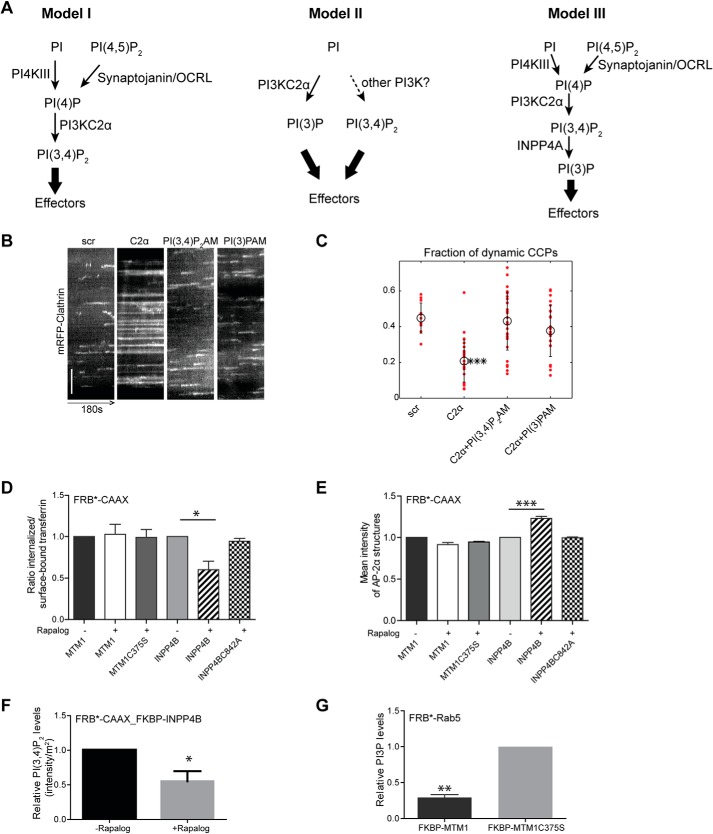Figure 1.
Acute manipulation of PI 3-phosphates reveals an endocytic function of PI(3,4)P2. A, proposed models of phosphoinositide conversion in CME. Model I, CCP maturation is accompanied by lipid conversion from PI(4,5)P2 to PI(4)P PI(3,4)P2 generated by PI3KC2α. PI(3,4)P2 can recruit effector proteins (e.g. SNX9/18) to facilitate CCP maturation. Model II, PI3KC2α synthesizes PI(3)P at the plasma membrane, alleviating the need for PI(3,4)P2 4-phosphatases. Effector proteins may bind to PI(3)P to facilitate CCP maturation. The kinase responsible for PI(3,4)P2 synthesis has not been identified in this study (16). Model III, PI(3,4)P2 synthesized locally by PI3KC2α is converted rapidly to PI(3)P at CCPs by the PI(3,4)P2-specific 4-phosphatase INPP4A, resulting in generation of PI(3)P. Effector proteins may bind to PI(3)P to facilitate CCP maturation. B and C, supply of exogenous PI(3,4)P2/AM or PI(3)P/AM rescues stalled CCP dynamics in PI3KC2α-depleted cells. Kymographs of COS7 cells expressing mRFP-clathrin fluorescence over 180 s by TIRF imaging are shown in B. y axis scale bar = 5 μm. Scr, scrambled. C, fraction of dynamic CCPs analyzed by quantitative automated 2D tracking. Mean ± S.E., *** p < 0.001. D, acute depletion of PI(3,4)P2 by rapalog-induced recruitment of INPP4B impairs transferrin CME. Depletion of a postulated plasma membrane PI(3)P pool by rapalog-induced recruitment of the PI(3)P 3-phosphatase MTM1 had no effect. Phosphatase inactive variants of INPP4B (C842A) or MTM1 (C375S) did not impair transferrin-CME. Bar diagrams represent the ratio of internalized (10 min, 37 °C) to surface transferrin (45 min, 4 °C). Mean ± S.E., n = 3 independent experiments. 790, 890, 916, 444, 332, and 1097 cells from three independent experiments were analyzed. *, p < 0.05; one-way ANOVA. E, accumulation of AP-2α–containing CCPs in PI(3,4)P2-depleted cells. Bar diagrams represent the mean intensity of endocytic AP-2α–containing CCPs. Mean ± S.E.; n = 3 independent experiments. 179, 158, 119, 109, 119, and 116 cells from three independent experiments were analyzed. ***, p < 0.001; one-way ANOVA. F, rapalog-induced recruitment of INPP4B to the plasma membrane results in decreased PI(3,4)P2 levels. Mean ± S.E, n = 3 independent experiments. 69 cells were analyzed from three independent experiments for each condition. *, p < 0.05; unpaired t test. G, rapalog-induced endosomal recruitment of WT but not inactive (C375S) MTM1 depletes PI(3)P from endosomes. Mean ± S.E., n = 3 independent experiments. 54 and 64 cells were analyzed. **, p < 0.01; unpaired t test.

